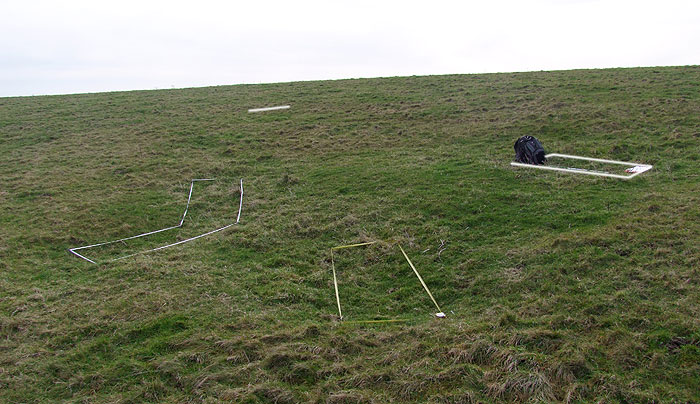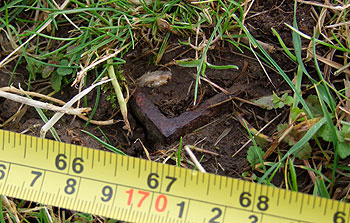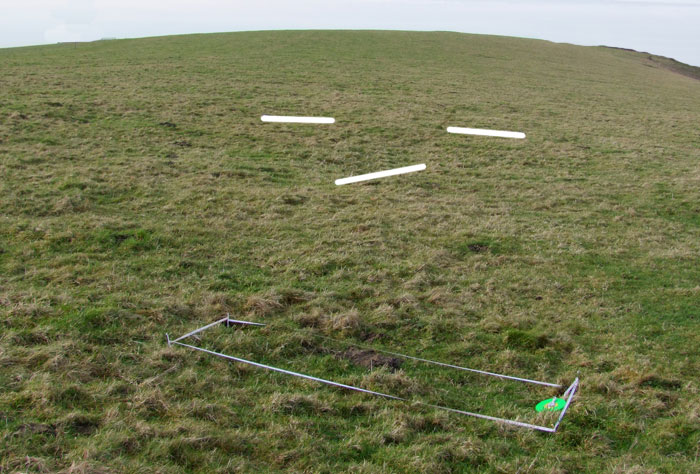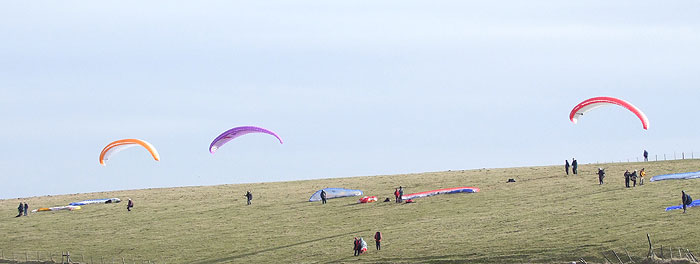Eight new trenches
Posted: 24 January 2009 22:17
I returned today to the spot where I found two new section localities on my previous visit and am fairly certain that I've found eight new trenches with two pieces of luck.
The first piece of luck lead to the discovery of the three trenches in the foreground in the photo below.

In the background is indicated the rough location of the trench I photographed last week; I was always wondering why this trench was sitting in isolation as all positions were to be sited for mutal support.
Moving about 20m away, I came across this group of three, but was by no means certain they were trenches. I could see three depressions in the ground but was caught between a rock and a hard place; either all of them were trenches, or none of them were.

An initial walk around the area got me thinking about the left hand (L-shaped) trench but I wasn't sure until laying out the tape measure and was lucky to get a glimpse of this angle picket that was only about 3mm above ground level. This clinched the indentity of this trench, but then if this was a trench, then so were the other two depressions.
It is an odd group though; the three trenches are a lot closer together than I would normally expect; one German shell landing in the middle would effectively render a section of men as casualties or fatalities. Whether the fourth one is too far out to be part of this group also remains to be answered.
I moved on to the second locality; again, in this one I had only one definite trench, confirmed by the presence of pickets and battered corrugated iron. The photo below shows the layout.

The trench in the foreground was again, found by a similar piece of luck. It exists as a depression not easily recognised and just a couple of metres from a path I have walked 20-30 times in recent months without ever noticing it.
The only reason I paid any attention now was the close proximity of the other (now identified) trenches; two had pickets while one was an obvious pit in the ground.
The likelihood of discovering this trench was so small that it's made me realise that there's probably still a large number of trenches on this ground that will remain undetected. Without confirmation in the presence of pickets, corrugated iron or an obvious sunken hollow, such features will inevitably be overlooked.
A question you're probably asking is why I don't use a metal detector. This is because I don't have one, there's all sorts of issues (such as gaining permission from the landowner) involved and because I could spend a lot of time digging unnecessary holes in the landscape rather than just getting on with what has so far been returning outstanding results.
However, I have two section localities that have odd layouts; they cover the ground in all-round defence after a fashion, but some trenches are arranged in way that doesn't make complete sense.
One useful bonus of today was working a short distance away from the local paragliding club. One of Downforce's key roles was to watch for and deal with German paratroops landing on the high ground. Although modern paragliding is a far more graceful, slow and controllable experience than jumping out of a Junkers Ju52 wearing an RZ20 parachute rig that doesn't allow you to safely carry much in the way of weaponry or equipment, you get an idea of the vulnerability not only of a descending Fallschirmjäger but also of the landscape; this is why Downsforce was constituted and dug in on these isolated slopes.

A satisfying day; even if I don't yet fully understand everything I've discovered about slit trenches, I've learnt a lot and also learnt that I've still got a lot more to learn and discover.
- Pete

Email:
Blog Latest

Bishopstone reveals its pillbox secrets
18 October 2021

Pillbox or Observation Post?
10 June 2020

Uncovering the hidden secrets of a pillbox
8 June 2019

Review of 2018
31 December 2018

Wartime Christmas in East Sussex (2)
24 December 2018
Jargon-buster
Angle picket
Iron stake made in several lengths used for construction of barbed wire obstacles or to hold trench revetment in place.
Slit trench
Small, narrow trench designed to provide protection against shrapnel and other battlefield hazards. Technically distinct from a weapon pit (which was intended soley as a defensive position) slit trenches were also used as defence works.
This site is copyright © Peter Hibbs 2006 - 2024. All rights reserved.
Hibbs, Peter Eight new trenches (2024) Available at: http://www.pillbox.org.uk/blog/216602/ Accessed: 19 April 2024
The information on this website is intended solely to describe the ongoing research activity of The Defence of East Sussex Project; it is not comprehensive or properly presented. It is therefore NOT suitable as a basis for producing derivative works or surveys!